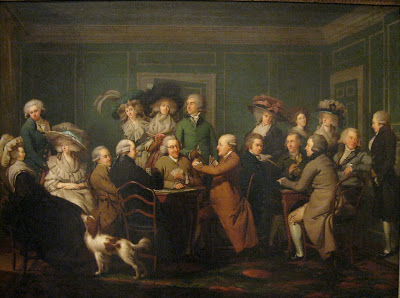As can be imagined, this week’s Breakfast Links have the distinct flavor of royal weddings recent and long past. But there’s also more assorted fare to be found in our weekly collection of links, blogs, and news snippets gathered from the Twitterverse. Enjoy!
• Flutter away: 19th c Spanish fans on a grand scale: http://bit.ly/emF7RF
• Wish books were still illustrated like this: N. C. Wyeth's art for James Boyd's Revolutionary War novel DRUMS: http://bit.ly/gvZXoh
• Beautiful view of 19th c seaport: http://bit.ly/hLjv0T Town of Gloucester, 1835-1836, by Fitz Henry Lane
• Abraham Adcock, Handel's trumpeter:http://bit.ly/fRPwHL
• Love this idyllic slideshow: Gravetye Manor - http://bit.ly/i7YoFf
• A pair of 18th c wedding shoes: red, not white: http://bit.ly/eTqvc8
• Do you pine to knit Jane Eyre's shawl for running about the moors? http://bit.ly/hODOI5
• And they’re not Caspar, Melchior & Balthasar: Famous Three Kings pub sign, Clerkenwell. http://twitpic.com/4pitgk
• Yes! 18th c Americans ate their vegetables & plenty of them, too: http://bit.ly/dJVxuR
• Pretty quick, & pretty terrifying: Plastic Surgery in 1910 http://bit.ly/fXfO4s
• White fur coats on the shoulders of glamorous young starlets: Caught on Film: A 1930s Hollywood Premiere http://bit.ly/lgcllg
• The Rise and Fall of 'Ladies Only' Railway Accommodation in 19th Century England' http://bit.ly/i156PI
• Wedding garters: Hare-skin garters for runaway brides, & a diamond one for Prince Albert: http://bit.ly/eicRsE
• Unusual 1871 star-patterned quilt fragment from 1854 Godey's Lady Book pattern: http://bit.ly/f3KO6b
• Sad to lose such beautiful buildings: melancholy before & afters (use the Fade bar to see the difference). http://bit.ly/jD279Y
• Whoa: fine art Barbies: http://bit.ly/h1SMtf
• All the floral symbolism in the decorations on the royal wedding cake. http://bit.ly/fv4aos And photos of the finished cake itself: http://bit.ly/k5UhLc
• A "dainty dish" from 18th c tables: Small loaves with oyster ragout (both 18th c recipe & modern version:
• In another symbolic touch, the Countess of Cambridge's bridal bouquet has been placed on the grave of the unknown warrior: http://bit.ly/l8CmOj

























